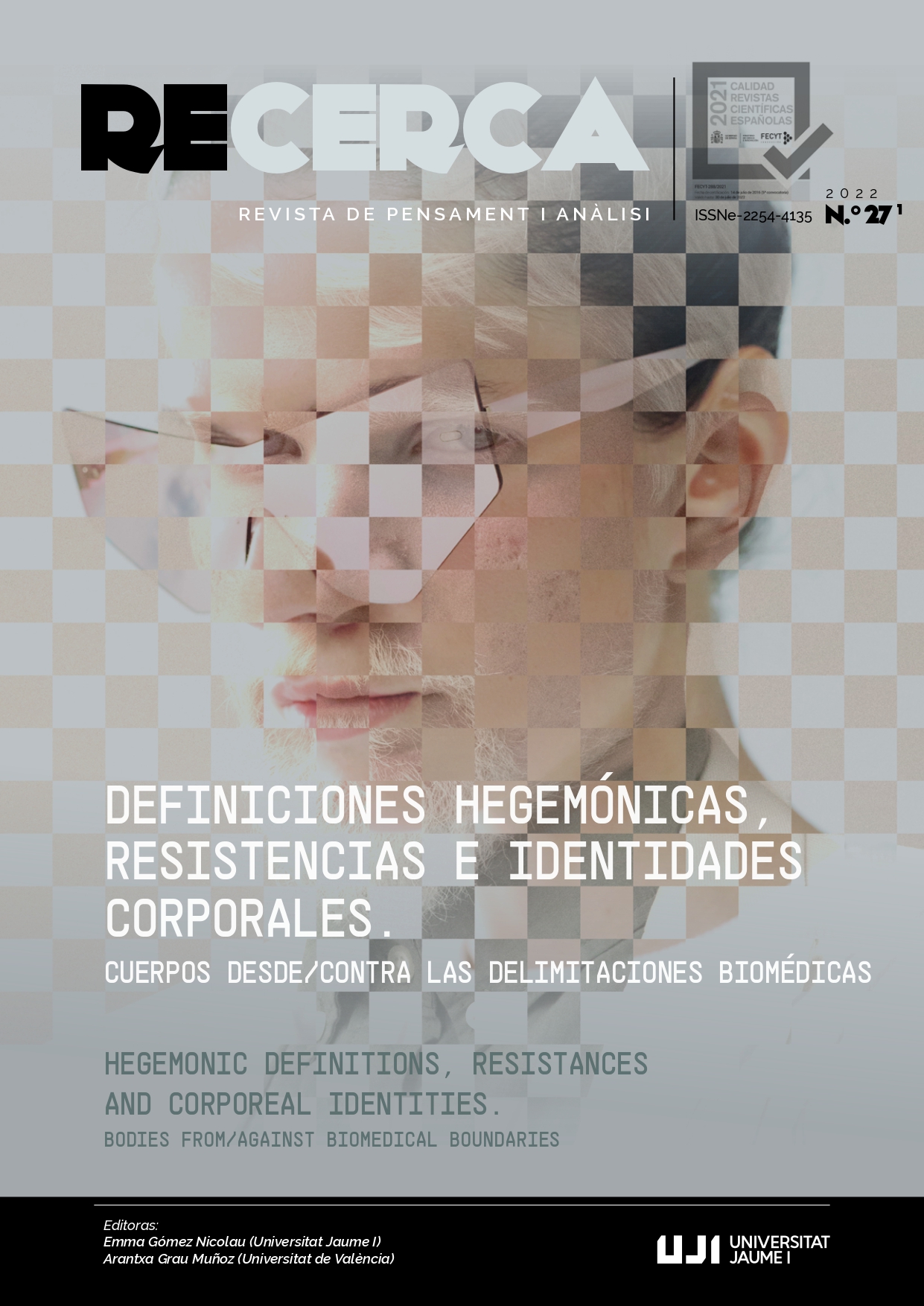Theorizing immune inhibition and TNF inhibitors from the autoimmune
Main Article Content
Abstract
This article analyses the biochemical object of tnf inhibitors from the perspective of living with an autoimmune disease. The author tries to tease out how the concept of immune inhibition is used in tandem with the biochemical object of tnf inhibitors to dominate in defining and narrating what health and disease, normal and pathological, cure and healing can mean in the context of autoimmune bodies. Specifically, and within the ‘pathological’ framework of autoimmune diseases, the pharmacological treatment of tnf (tumour necrosis factor) inhibition is designed to suppress the ‘overly’ active immune system, thus acting as a negative or suppressing biochemical agent aimed at putting the ‘malfunctioning’ immune system back in balance. As can be seen in the current conjuncture, tnf inhibitors officially —and governmentally— place those taking them in a risk group, as they 'lower' their overall bodily immunity and make them more vulnerable to infectious diseases, while stabilizing their patho-logical, ‘over’-immune uninhibited condition. Part personal narrative of being diagnosed with an autoimmune condition, part speculative autoimmune theory inspired by such a diagnosis, the article ultimately calls for a different form of embodiment that is neither negative nor affirmative, and yet is resistant even to itself.
Downloads
Article Details
References
Agamben, Giorgio (2005). The time that remains: A commentary on the Letter to the Romans. Stanford University Press, 2005.
Aggarwal, Bharat B., Gupta, Subash C. and Kim, Ji Hye (2012). Historical perspectives on tumor necrosis factor and its superfamily: 25 years later, a golden journey. Blood, 119(3), 651-665.
Braidotti, Rosi (2019). A Theoretical Framework for the Critical Posthumanities. Theory, Culture & Society, 36(6), 31-61.
Canguilhem, Georges (1991). The Normal and the Pathological. Zone Books.
Cohen, Ed (2017). Self, Not-Self, Not Not-Self But Not Self, or The Knotty Paradoxes of ‘Autoimmunity’: A Genealogical Rumination. Parallax, 23(1), 28-45.
Derrida, Jaques (1981). Dissemination. The University of Chicago Press.
Ferri, Beth A. (2018). Metaphors of Contagion and the Autoimmune Body. Feminist Formations, 30 (1), 1-20.
Foucault, Michel (2007). Security, Territory, Population: Lectures at the Collège de France, 1977-1978. London: Palgrave Macmillan.
Foucault, Michel (2008). The Birth of Biopolitics: Lectures at the Collège de France, 1978-1979. Basingstoke: Palgrave MacMillan.
Frost, Samantha (2016). Biocultural Creatures: Toward a New Theory of the Human. Duke University Press.
Haraway, Donna (1988). Situated Knowledges: The Science Question in Feminism and the Privilege of Partial Perspective. Feminist Studies, 14(3), 575-599.
Hobbes, Thomas (1651). Leviathan or The Matter, Form and Power of a Common-Wealth Ecclesiasticall and Civil. London.
HUMIRA, A Biologic Treatment Option (2020). Taken from https://Www.Humira.Com/ (accessed 7 August, 2020).
Lavaert, Sonja and Gielen, Pascal (2009). The Dismeasure of Art. An interview with Paolo Virno. In Gielen, Pascal and De Bruyne, Paul (eds.). Arts in Society. Being an Artist in Post-Fordist Times (17-44). NAi Publisher.
Lemke, Thomas (2011). Beyond Foucault. In Ulrich Bröckling, Susanne Krassmann y Thomas Lemke (comps.). Governmentality. Current issues and future challenges (165-184). New York & London: Routledge.
Montfort, Anne et al. (2019) The TNF Paradox in Cancer Progression and Immunotherapy. Frontiers in immunology, 10, 1818.
Nobel Prizes (2018). NobelPrize.Org. Taken from www.nobelprize.org/prizes/medicine/2018/press-release (accessed 7 August, 2020).
Pardoll, Drew M. (2012). The blockade of immune checkpoints in cancer immunotherapy. Nature reviews. Cancer, 12(4), 252-264.
Rajan, Kaushik Sunder (2021). Multisituated: Ethnography as Diasporic Praxis. Duke University Press.
Schmitt, Carl (2006 [1950]). The Nomos of the Earth in the International Law of the Jus Publicum Europaeum. Telos Press Publishing.
Solomon, Daniel H., Mercer, Emileigh and Kavanaugh, Arthur (2012). Observational studies on the risk of cancer associated with tumor necrosis factor inhibitors in rheumatoid arthritis: a review of their methodologies and results. Arthritis and rheumatism, 64(1), 21-32.
Steeland, Sophie, Libert, Claude and Vandenbroucke, Roosamarjin E. (2018). The New Venue of TNF Targeting. International journal of molecular sciences, 19(5), 1442.
Tisoncik, Jennifer et al. (2012). Into the eye of the cytokine storm. Microbiology and molecular biology reviews: MMBR, 76(1), 16-32.
Urquhart, Lisa (2020). Top product forecasts for 2020. Nature Reviews Drug Discovery, 19, 86.
Virno, Paolo (2008). Multitude between innovation and negation. Semiotext(e).
Virno, Paolo (2018). An Essay on Negation: For a Linguistic Anthropology. Seagull Books.
Wang, Xia and Lin, Yong (2008). Tumor necrosis factor and cancer, buddies or foes? Acta pharmacologica Sinica, 29(11), 1275-1288.


